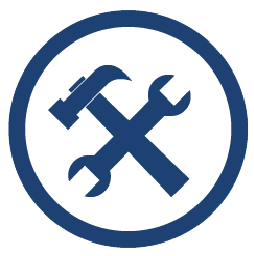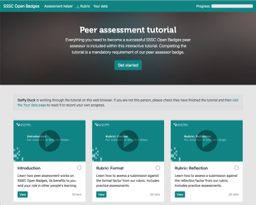Module 5 - Section 1
First Principles
Assessment design is a huge and important topic…
From a design perspective it’s vital that learning activities
are aligned to assessment activities.
Assessment design is a huge and important topic. Assessments should be mapped to learning outcomes and measure the learners’ knowledge and skills in an authentic (real-life) context. From a design perspective it’s vital that learning activities are aligned to assessment activities. So, if the summative assessment is an online multiple choice quiz, the design ought to include a number of formative online multiple choice quizzes, using the same technology. Likewise, if the summative assessment is an e-portfolio, the learner must be introduced to the e-portfolio platform early, and scaffolded activities incorporated to develop specific e-portfolio skills.
Online assessment, or e-assessment, is likely to include:
- Assignments – online or email submission of a “traditional” assignment like an essay or report
- Discussion – asynchronous communication in a discussion forum can be assessed
- e-Portfolios – e-portfolio assessment is popular in criteria-based qualifications, work-based qualifications, creative subjects, and areas where reflection is important (education, medicine, CPD)
- Blogs / diaries – shared or personal reflections
- Peer assessment – digital tools make peer assessment much easier to implement, with some VLEs incorporating specific tools for the management and grading of peer assessment
- Content creation – there are many online tools for creating multimedia content which can provide an opportunity for authentic assessment developing a broad range of skills
- Quizzes – most Virtual Learning Environments (VLEs) have the ability to create quizzes using a variety of questions types.
Other technology-driven approaches include:
- Simulation – simulation has been used for some time in areas like aviation and medicine and can incorporate a variety of scenarios that would be impossible to replicate in real life
- Virtual Reality – takes simulation to the next level and opens up opportunities to experience sophisticated, immersive, scenario based learning and assessment, in areas as diverse as social care, ethics, historical events, surgery, and serious emergencies
- Adaptive – adaptive platforms provide a personalised learning and assessment journey; the software may signpost to supplementary practice or specific support materials after identifying areas for development through some means of assessment
- Games based assessment – games design continues to influence learning and assessment as the learning activities and related interaction are used as evidence of what a learner knows and can do
More practical guidance on creating e-assessment here http://citea.digitalinsite.co.uk
Assessments And Its Impact On Learning
It’s tempting to think of assessment as having one purpose; to determine what you have learned or what you know. But, in reality, assessment can have a range of purposes or intentions. In this module we’ll look at,
- Assessment for learning
- Assessment as learning
- Assessment of learning
Along the way, we’ll also look at managing learner feedback, consider
the role of micro credentials and open badges in the assessment of
digital learning and, look at examples of technology offering more
innovative approaches to assessment of learning.
But before we get started, we’d like you to watch this lecture by
Professor Eric Mazur for an alternative view on the impact of
assessment on learning - it’s around an hour long, but well worth
watching:
Assessment For Learning
A concept regularly used by academics but rarely understood. An active learning lesson will include a series of plenaries and stages. Each stage in a learning unit, will be timed and will include a strategy for the assessment or review of outcomes. The formal assessment, or, final judgement of learning (e.g. where there is a grade) is not assessment for learning, it is assessment of learning. Probably the easiest way to consider this is to think of the tools the trainer uses to promote and engage learners in dialogues (called reflections/discussions), where the trainer/tutor actively invokes a sense of curiosity around a topic or point. This is not for the purpose of formal grading or assessed outcomes, rather it is to support the learners in their quest for understanding or skill development. As such, it is assessment ‘for’ the learners and not ‘for’ the trainer (who will want to understand ‘what’ learning has taken place, assessment of learning). Strategies that work best will include formative tools which invoke a dialogue. The dialogue in the digital world may be self or peer led but should always include a tutor/facilitator.
Assessment As Learning
The new analogy, known to many in education and training, as the hidden tools of the experienced teacher who probes for learning. This form of assessment is a philosophy for teaching, where the tutor/trainer regularly reinforces a learner, a tutor who is ‘with-it’ at all times and who is open to a flexible learning plan that meets the needs of the individual, first and foremost. Petty’s model of active learning is promoted in the lecture series as a way to engage learners in ‘deeper’ reflections and experiences. This can only be achieved where assessment as learning is used. The premise used throughout this process, linked to previous learning (Gilly Salmon for example), is very simply about building ‘constructs’ as ‘activities’ to supplement assessment as learning and the reinforcement of assessment/learning outcomes. The big focus for assessment as learning is on motivation and the stimulation of learning. Digital tools such as forums for collaboration, blogging and social media (as covered in Module 4 - Learning in a Networked World) as well as the use of personalised feedback loops and synchronous communications can supplement learning while quality assuring assessments.
Assessment Of Learning
This type of assessment is usually derived from formal systems and procedures, often moderated by external sources/awarding institutions or bodies. Assessment of learning is linked to the explicit nature of a curriculum plan, where the tutor/trainer is required to demonstrate the competence or achievements of the learners with grades/marks and credential type outcomes. Many theorists would support the view that this type of formalised assessment, tests/exams and the like, promote a culture of surface or strategic learners. While it has its place, particularly to demonstrate the standards of a qualification, it is not wholly viewed as a tool to aid learning and, most tutors/trainers would agree it can as a ‘process’ be detrimental to the learning journey. Balance is everything though. The assessment

Activity 1
Blog
Thinking about these different types of assessment, consider the following questions and record your answers on your blog:
- Can you identify learning experiences which have included assessment activities in each of these categories?
- Which of the assessment types did you feel gave you the most benefit as a learner?
- Can you identify learning experiences you are responsible for where you could create assessment options in each category?
As we suggested in Module 2 “What Works?”, our goal in designing learning experiences should be learning transfer - encouraging learners t apply their learning to real world situations. We also suggested that authentic assessment had a key role to play in this process. So to reinforce that, we like to leave you with a key message:
“Make the assessment tasks mimic the real-world tasks. Even if it’s via multiple choice, have the question mimic the decision one needs to make, not the knowledge one needs to make it. If that knowledge needs to be automated, do so, but then have learners apply that knowledge. Otherwise, question why it’s needed.”
Peer Assessment
So, it’s no real surprise that the most common approach to scaling up assessment is to use automated multiple choice quizzes. However, as is suggested by the quote from Quinn’s book above, we need to be careful how much we read in to this approach
“We need to distinguish between recognition and recall. Many multiple-choice questions ask you to identify the correct response to a question rather than pull it out of memory, like a short-answer question. This is actually recognition. If we ask you to generate the response, we’re asking you to recall. Recognition is a simpler, and different, task than recall…
However, if you really need people to be able to recall something rather than just recognize it, or more likely be able to recall and use the information, ensure that you develop the appropriate retrieval practice. That is, have learners retrieve and apply information in practice as they will need to do it in performance.”
So what’s the alternative? One viable solution is Peer Assessment. Peer assessment is a process by which learners rate their peers. The learners consider the amount, level, value, worth, quality or success of learning of peers of similar status. In other words, reviewing work of other learners against set criteria. (see https://www.tes.com/news/pedagogy-focus-peer-assessment ).
“Peer assessment involves students taking responsibility for assessing the work of their peers against set assessment criteria. They can therefore be engaged in providing feedback to their peers (sometimes referred to as peer review), summative grades (moderated by [programme staff]), or a combination of the two.”
In addition to the obvious benefits to digital learning providers, there are additional benefits for learners as the process of reviewing and assessing peers’ work necessitate the assessor reviewing their own understanding of the area in question and therefore can contribute to reinforcing that learning (see https://teaching.cornell.edu/spring-teaching-resources/assessment-evaluation/peer-assessment and https://tinyurl.com/vm98rmhm for more on this).
One of the common concerns voiced regarding peer assessment is that leaners may collude in giving each other positive grades or assessments. However, if has no control over what they are assessing and no information on whose evidence/submission they are assessing, or where the are working and/or studying, this concern can be nullified. The comercial Peerscholoar system has this built in to its operation (see https://vision.peerscholar.com) as does the SSSC Open Badge system. SSSC also has comprehensive in place to prepare people to take on a peer assessor role:
See https://learn.sssc.uk.com/peer/ for more information.


Activity 2
Blog
Work through the SSSC peer assessment tutorial as detailed here, consider the following questions and record your answers on your blog:
- Do you think this tutorial would give you the confidence to be a peer assessor?
- Describe how you might be able to apply peer assessment to learning experiences you develop?